The history of the A.J. Reach Company, once the leading manufacturer of baseball goods in the world, is intertwined within the story its founders, Alfred James Reach and Benjamin Franklin Shibe, men of humble birth who, through innovation and industry, capitalized on the booming popularity of baseball after the Civil War and became instrumental in establishing the institution of American professional baseball.
Alfred James "Al" Reach - Early Life
In 1841, Benjamin and Elizabeth Dyball Reach emigrated to the United States from London, England. They settled in Williamsburg, New York, a suburb of Brooklyn, where Benjamin worked as a trading agent and the pair raised three boys and four daughters. Their second son, Alfred James "Al" Reach (b. 1840) was a hard-working, athletic child who found work as a newsboy and ship caulker as a youth, and as an iron moulder apprentice by the age of 15. Outside of the long hours he spent toiling in the foundry, Al could be found playing baseball on Brooklyn's sandlots. An excellent fielder and fast runner, in the late 1850's Al founded the Jackson Junior Base Ball Club (named after president Andrew Jackson) where he served as manager, captain, and catcher [1]. Later accounts even credited young Al with providing the team with uniforms manufactured by his mother, enlisting his friend and New York shoemaker, John Van Horn, to make the team's baseballs out of leather scraps, and employing a local wood-turner to produce the team's bats [2].

Chris Hornung
February 24, 2018
February 24, 2018
Maker Spotlight:
The History of A.J. Reach & Co.
The History of A.J. Reach & Co.
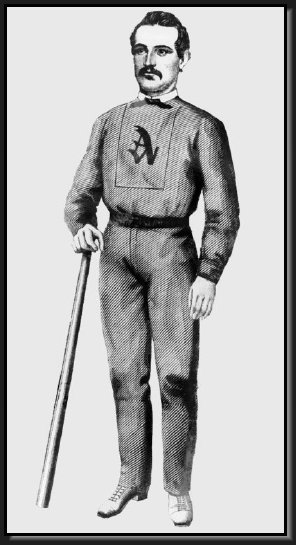
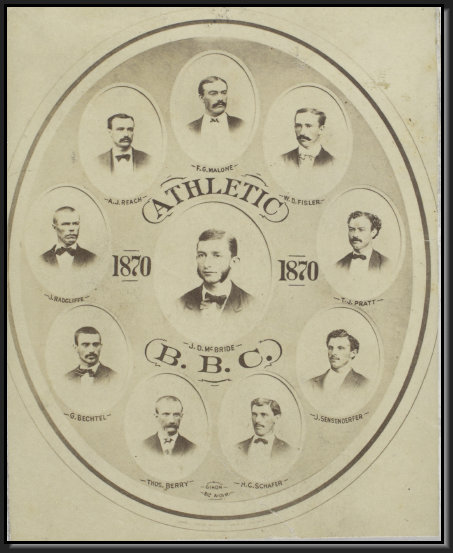
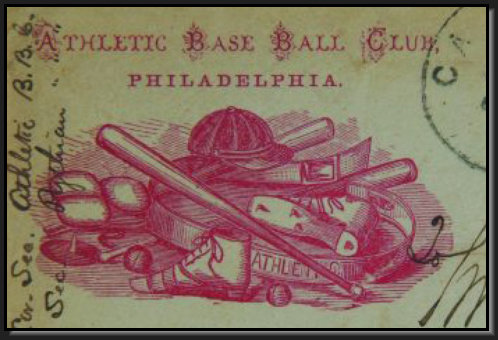
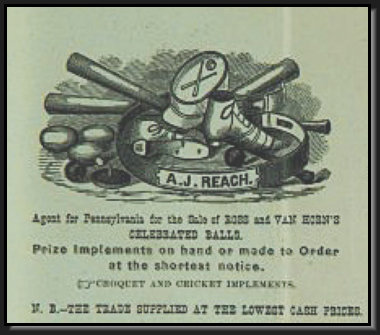
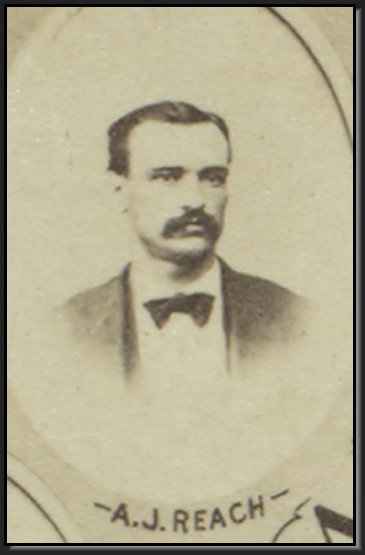
Base Ball Goods Agent
Benjamin Franklin Shibe
Benjamin Franklin Shibe was born in Philadelphia on January 23, 1838, the tenth of eleven children of John D. and Rachel Ann Dingee Shibe. As a child, Ben had a passion for baseball and became an ardent follower of the Athletics. However, he was unable to fully participate in sports due to an accident which required him to wear a leg brace. Ben's first job was as a horsecar driver on the Philadelphia streets. In his spare time he worked leather into whips and watch fobs in the small hardware and home furnishing business of oldest brother, John D. Shibe (b. 1817). In 1863, Ben enlisted in the Union Army in response to the Confederate invasion of Pennsylvania, but mustered out several months later without seeing any combat. On March 30, 1866, he married Josephine Freyhardt, who would give birth to two sons and two daughters by 1873.
In the late 1860's, Ben's nephew Dan Shibe began manufacturing cricket balls in a back room of John's hardware store [6], and soon turned his attention to baseballs in response to the growing popularity of the sport following the Civil War. Ben, who joined Dan in his free time, would later be described as "the most practical and able ball maker" [7] in the family. By 1875, the popularity of Ben's baseballs had grown such that John and Ben formed a new "ball manufacturing" company, John D. Shibe & Co. They began operations at 1311 Palmer Street, which was John, Ben and Daniel's home in 1875, and the company soon developed a national reputation as quality ballmakers. Their balls included the "Cock-of-the-Walk," "Skyrocket," "Bounding Rock," "Red Stocking," and "Red Dead" balls [6]. Reach & Johnston became one of the Shibe's best customers, and Ben and Al soon developed a friendship.
In the late 1860's, Ben's nephew Dan Shibe began manufacturing cricket balls in a back room of John's hardware store [6], and soon turned his attention to baseballs in response to the growing popularity of the sport following the Civil War. Ben, who joined Dan in his free time, would later be described as "the most practical and able ball maker" [7] in the family. By 1875, the popularity of Ben's baseballs had grown such that John and Ben formed a new "ball manufacturing" company, John D. Shibe & Co. They began operations at 1311 Palmer Street, which was John, Ben and Daniel's home in 1875, and the company soon developed a national reputation as quality ballmakers. Their balls included the "Cock-of-the-Walk," "Skyrocket," "Bounding Rock," "Red Stocking," and "Red Dead" balls [6]. Reach & Johnston became one of the Shibe's best customers, and Ben and Al soon developed a friendship.
By 1859, Al's athletic prowess had gained the attention of one of the top baseball clubs in America, the "Eckford of Brooklyn." Formed in 1855 by the shipbuilder Henry Eckford, the "Eckfords" were one of the founding members of the National Association of Base Ball Players in 1857. In 1862, the team was playing its games at Union Grounds in Williamsburg, in what was the first enclosed baseball field ever constructed [3]. Eventually moving to second base, Reach would help lead the Eckfords to the National Amateur Association pennant in 1862 and 1863.
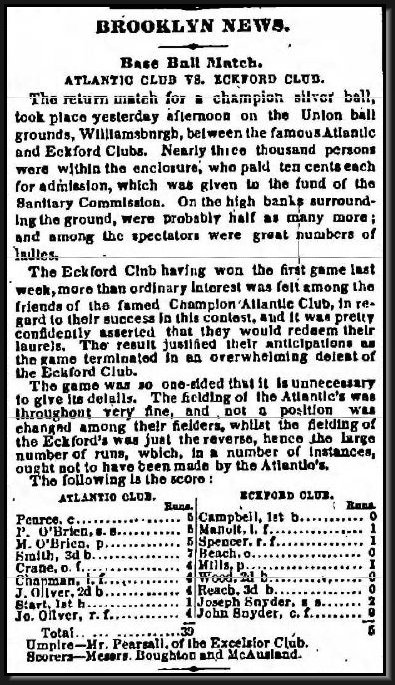
The Eckford of Brooklyn
Formed in 1859, the Athletic Base Ball Club of Philadelphia (the "Athletics") joined the National Amateur Association in 1861. Eager to build a winner to compete with New York clubs, the team's owner, Colonel Thomas Fitzgerald, enticed Reach to leave Brooklyn for Philadelphia in 1865 by secretly offering to pay him $25 per week for "expenses," an extraordinary sum and a violation of amateur rules. Reach agreed and, as a result, would later be recognized as one of the sport's first paid professionals.
The Athletic Base Ball Club of Philadelphia
5'-6" and 155 pounds, the diminutive left-hander was regarded as a "grand fielder at second base, a wonderfully fast runner, a hard and accurate thrower, and a terrific hitter." Reach was also an innovator. He is credited with being the first second baseman to play behind the bag between first and second base, and for developing the strategy of sharing second base defensive duties with the shortstop [4].
During the 1865 season, Reach commuted to Philadelphia from his home and fiancee, Louise Betts, in Brooklyn. Eager to keep his star grounded in Philadelphia, Fitzgerald helped Reach open a cigar and tobacco shop at 404-1/2 Chestnut Avenue in 1866. On December 25, 1866, Al and Louise Reach were married and took up permanent residence in Philadelphia.
During the 1865 season, Reach commuted to Philadelphia from his home and fiancee, Louise Betts, in Brooklyn. Eager to keep his star grounded in Philadelphia, Fitzgerald helped Reach open a cigar and tobacco shop at 404-1/2 Chestnut Avenue in 1866. On December 25, 1866, Al and Louise Reach were married and took up permanent residence in Philadelphia.
October 30, 1865 Harper's Weekly Woodcut of Game Between Philadelphia Athletics and Brooklyn Atlantics
The New York Tribune, July 22, 1862
Al and his fellow Athletics congregated at the cigar shop before and after games, making the venue a popular hangout for fans and local businessmen and a logical place to sell game tickets and baseball supplies. By 1867, in addition to being a "tobacconist," Reach advertised himself as a wholesale and retail dealer in base ball implements, and an "agent for Pennsylvania for the sale of Ross and Van Horn's celebrated balls." By the mid 1860's, Van Horn had become one of the leading manufacturer of baseballs in the country [5], while Harvey Ross, a sail maker and member of the Atlantic Club of Brooklyn, was an equally well-regarded manufacturer from New York.
The earliest known advertisement for Reach's business venture, A.J. Reach, is an 1867 invoice for the sale of baseballs to the Pythian Base Ball Club, Philadelphia's first black baseball club. Reach's logo borrowed heavily from the design used by the Athletic Base Ball Club.
The earliest known advertisement for Reach's business venture, A.J. Reach, is an 1867 invoice for the sale of baseballs to the Pythian Base Ball Club, Philadelphia's first black baseball club. Reach's logo borrowed heavily from the design used by the Athletic Base Ball Club.
A.J. Reach Woodcut, c.1870
Enlargement of 1867 A.J. Reach invoice showing logo, Philaplace.com
Enlargement of 1867 Philadelphia Athletics envelope showing logo, Philaplace.com
During the late 1860's, the Athletics were considered one of the best teams in the country, however, there wouldn't be a national professional baseball league to settle the question until the formation of the National Association of Professional Base Ball Players in 1871. The Athletics joined the NAPBBP in 1871 and won the league's inaugural championship with a record of 21-7. Reach finished the season 3rd in fewest errors committed, 4th in fielding %, 5th in RBI's and strikeouts, 8th in triples, and 10th in batting average, on-base %, and runs. He also ranked as the 6th oldest player in the league at the age of 31.
Over the following four seasons, the NAPBBP would be dominated by the Boston Red Stockings. Led by superstars George Wright, Albert Spalding, and player-manager Harry Wright, Boston posted an 0.837 winning percentage on its way to four consecutive pennants between 1872 and 1875. With a 0.574 winning percentage over the same time period, Reach and the Athletics would remain an annual pennant contender, finishing 4th in 1872 and 2nd in 1873.
Over the following four seasons, the NAPBBP would be dominated by the Boston Red Stockings. Led by superstars George Wright, Albert Spalding, and player-manager Harry Wright, Boston posted an 0.837 winning percentage on its way to four consecutive pennants between 1872 and 1875. With a 0.574 winning percentage over the same time period, Reach and the Athletics would remain an annual pennant contender, finishing 4th in 1872 and 2nd in 1873.
In 1873, Harry Wright organized a baseball tour of England where the best of America brought its national pastime to Wright's native country. Wright convinced the Philadelphia Athletics to accompany the Red Stockings on the tour for a series of baseball exhibitions in British and European cities in the summer of 1874. The teams were also scheduled to participate in cricket matches against their hosts. A lack of publicity and advance planning resulted in disappointing turnouts and the trip was cut short. However, the tour afforded Reach the opportunity to build relationships with men poised to become major forces in the growth of professional baseball and American sporting goods. At the time, Wright and Reach were already proprietors of "segars and base ball goods" in Boston and Philadelphia respectively, and Spalding would open a sporting goods store in Chicago later that same year.
Perhaps influenced by conversations with Spalding and Wright, Reach began planning the next stage of his life upon his return. While he continued to play periodically for the Athletics, Reach's primary focus shifted from playing to team management and selling baseball goods. In 1874, he was named the Athletics business manager and opened Philadelphia's first sporting goods retail store on South 8th Street.
Perhaps influenced by conversations with Spalding and Wright, Reach began planning the next stage of his life upon his return. While he continued to play periodically for the Athletics, Reach's primary focus shifted from playing to team management and selling baseball goods. In 1874, he was named the Athletics business manager and opened Philadelphia's first sporting goods retail store on South 8th Street.







1870 Philadelphia Athletics CDV
J. D. Shibe & Co., circa 1890

Mutual Interest
In addition to both being involved in the manufacture and sale of baseball, Al Reach and Ben Shibe shared a mutual interest in bringing professional baseball back to Philadelphia. To promote their products, the Shibe brothers sponsored a new amateur baseball team in Philadelphia, the J.D. Shibe Club, in 1875, and hired former ballplayer and local businessman Bill Sharsig as manager. In September 1880, Sharsig left the Shibe team and founded his own semi-professional baseball club, the Philadelphia Athletics (no relation to the prior concern), with the backing of Shibe and several Philadelphia businessmen. The following year, Al Reach ($2,000), Tom Pratt ($2,000), and Colonel John Rogers ($1,000) joined Stephen Farrelly ($10,000) in organizing their own team, the Quaker City Club, to compete in the Eastern Championship League [8].
The Demise of the Athletics
In 1875, William Hulbert, owner of the Chicago White Stockings, founded the National League of Professional Baseball Clubs (the "National League") in an effort to improve the generally poor image of professional baseball. Most of the top NAPBBP teams, including the Athletics, would defect to the National League in 1876, but not before Hulbert convinced several of Boston's biggest stars, including Spalding, Ross Barnes, Deacon White, and Cal McVey, and Philadelphia's Cap Anson and Bob Addy, to play for Chicago. The founding of the National League proved disastrous for the Athletics, who finished in second to last place and were expelled from the league in 1876 for failing to play their final away games due to financial distress. The organization would disband after the season's end.
The Athletic's demise allowed the 36-year old Reach to concentrate his efforts on his sporting goods business. He took on Albert C. Johnston as a partner in 1876 and briefly renamed the business to Reach & Johnston.
The Athletic's demise allowed the 36-year old Reach to concentrate his efforts on his sporting goods business. He took on Albert C. Johnston as a partner in 1876 and briefly renamed the business to Reach & Johnston.
REFERENCES
